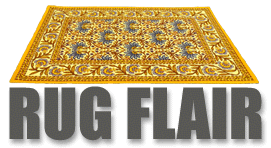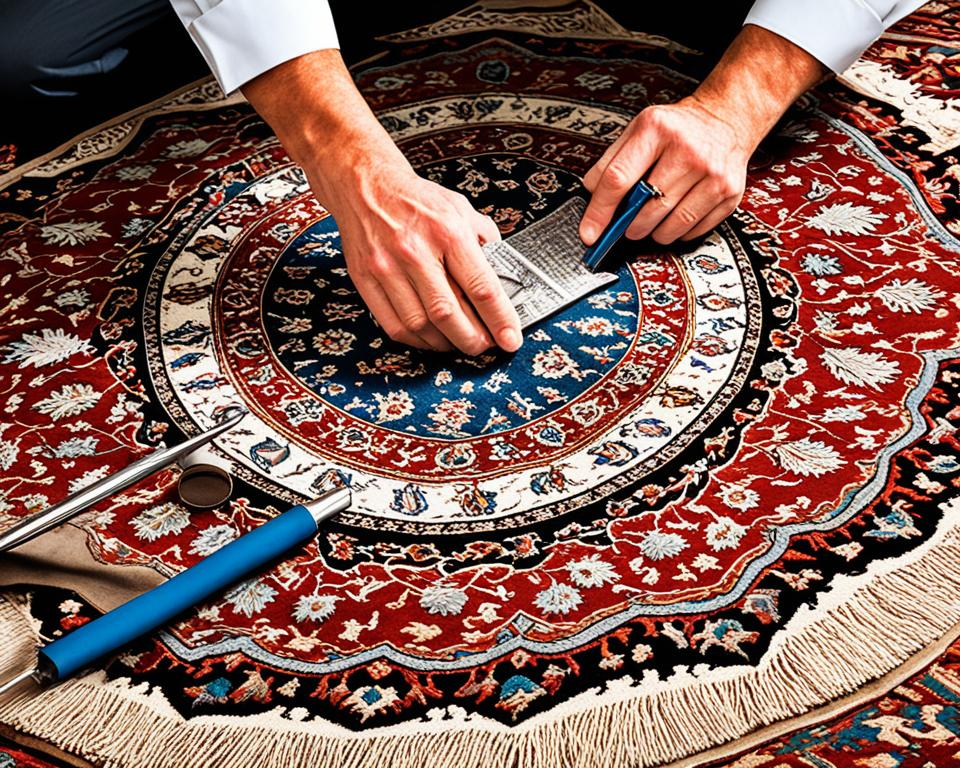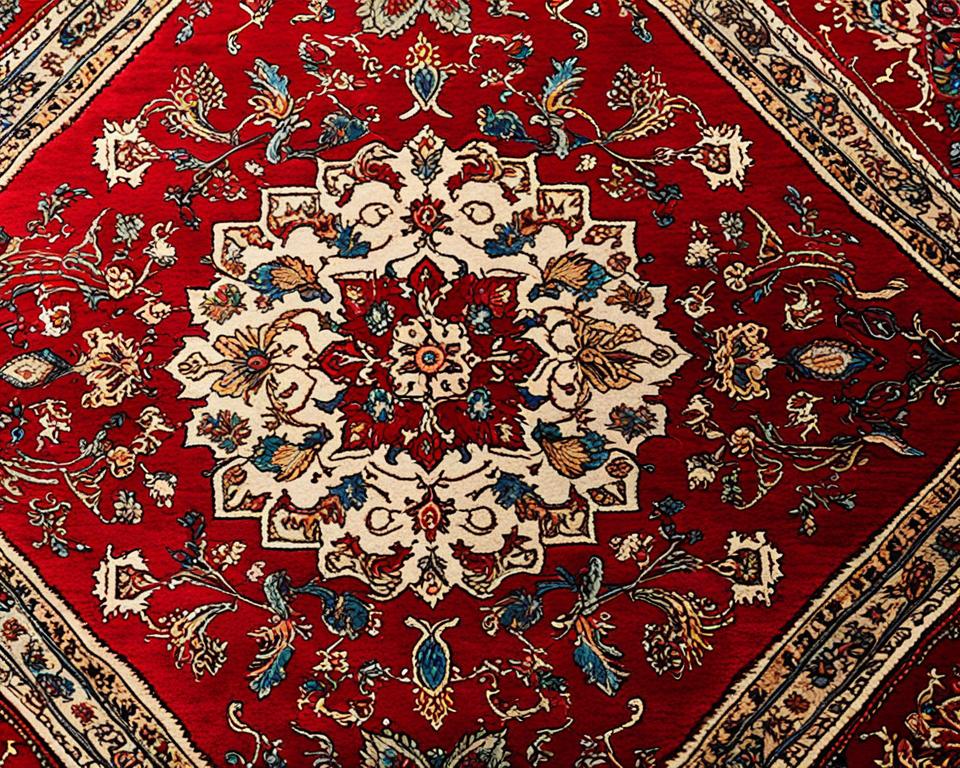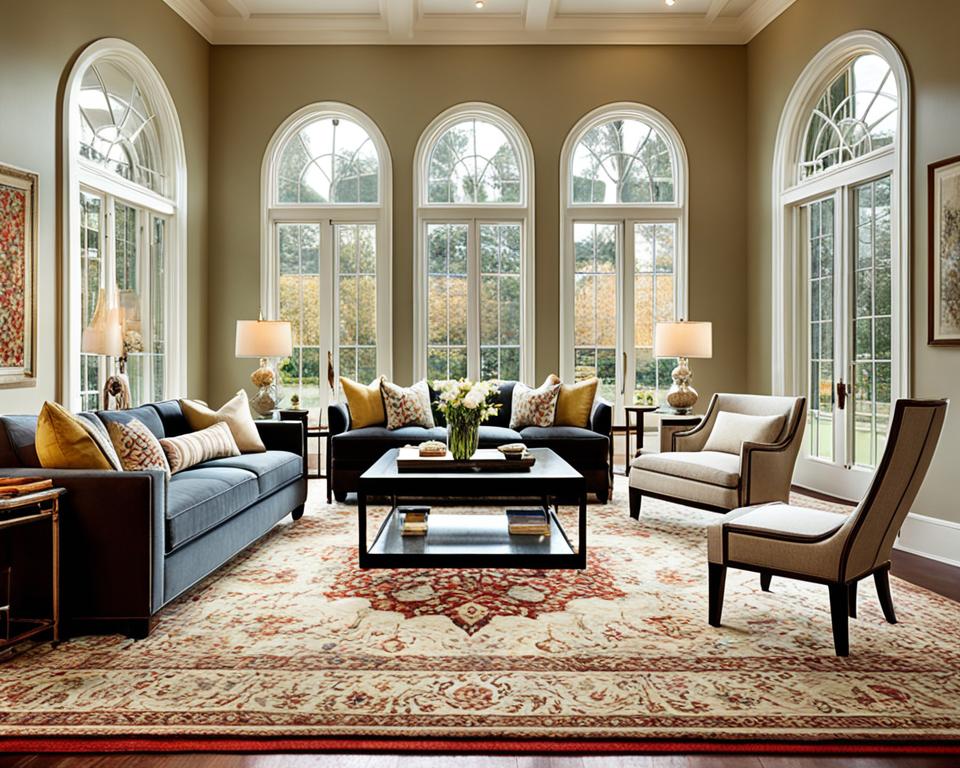Welcome to the world of Oriental Rug Review, where the allure of authentic handmade rugs meets the scrutiny of connoisseurship. Luxury rug recommendations entail more than just aesthetics; they embody a lineage of craftsmanship and cultural history. As you venture into the realm of these exquisite floor coverings, understand that you’re not merely buying a rug; you’re investing in a piece of art that has the potential to resonate through generations. Here, we provide you with the insight needed to discern truly luxurious weaves from the rest.
Key Takeaways
- Authentic Oriental rugs are not just décor; they are timeless investments with a story.
- Familiarize yourself with the signs of a genuine Oriental rug to make educated purchases.
- Expert insights can guide you toward luxury rugs that are both beautiful and valuable.
- Luxury rug recommendations will elevate not just floors, but lifestyles and interiors.
- Understanding the intricacies of Oriental rugs can enrich your appreciation for these heirloom-quality pieces.
The Artful Legacy of Oriental Rugs
Discover the best oriental rug brands that stand as testament to an immortal tradition, embracing both history and quality with every fiber. Oriental rugs, known for their meticulous pile-weaving and handcrafted quality, rise beyond mere floor coverings to become celebrated works of art within the home. These rugs carry a legacy that not only endures but flourishes in modern interiors, as they seamlessly blend luxurious textures with timeless designs to complement diverse living spaces and design preferences.
The demand for authentic oriental rugs has remained steadfast through generations, reflecting a discerning taste for premium textiles and intricate patterns. From classic motifs to tribal designs, the oriental rug’s versatility knows no bounds, appealing to a wide array of aesthetics and lifestyles. Whether adorning a cozy reading nook or accentuating the grandeur of a formal living room, these rugs are the cornerstone of opulence and sophistication.
Authentic Oriental rugs are investment pieces that become heirloom quality items, capable of being handed down from one generation to the next.
- Highlight the enduring craftsmanship reflected in each knot and color choice.
- Explore a rich tapestry of designs, spanning from the ornate to the minimalistic.
- Understand why top brands remain coveted for their unparalleled commitment to artistry.
In your journey to find the perfect oriental rug, you may encounter numerous makers and sellers. Rely on expert oriental rug reviews to guide you through a landscape rich with history and diversity. These guides and testimonials provide invaluable insight, helping you to distinguish the exquisite from the everyday, ensuring your investment is both prudent and passionate.
| Characteristic | Description | Impact |
|---|---|---|
| Material Quality | High-grade wool and silk | Enhances durability and feel |
| Design Complexity | Intricate patterns with historical significance | Adds depth and storytelling to spaces |
| Handcrafted Authenticity | Each rug hand-knotted by skilled artisans | Ensures unique, long-lasting beauty |
| Color Vibrancy | Use of natural dyes for rich, lasting hues | Brings warmth and vibrancy to interiors |
| Lifestyle Fit | Classic and tribal patterns suitable for various preferences | Aligns with individual lifestyles and décor themes |
As you contemplate adding the splendor of an oriental rug to your home, consider not only the aesthetic it brings but also the stories interwoven into its fabric. Let expert oriental rug reviews be your compass in this exquisite realm of textile art, where beauty and legacy intertwine underfoot.
Tracing the Origins: The Pazyryk Rug
As you delve into the realm of vintage rug reviews, the Pazyryk Rug stands as a paramount encounter with antiquity. Discovered serendipitously in the icy tombs of Siberia by Russian archaeologist Sergei Rudenko during the 1940s, the Pazyryk Rug captivates historians and rug aficionados alike. Its intricate weave and sophisticated design date back to the 5th century BCE, revealing the profound legacy and mastery of authentic handmade rugs. This treasured find illuminates the rug-making tradition that has been flowing through the threads of time, enduring over thousands of years.
The artistry enshrined within the Pazyryk Rug’s fibers tells a tale not merely of aesthetic prominence but of the cultural transcendence of Oriental rugs. Each pattern and dye used is reflective of a bygone era with practices preserved by devoted artisans to this day. When you consider acquiring an Oriental rug, you are not just purchasing a decorative item; you are becoming a part of a lineage that dates back to the early carpets of the nomadic tribes of the Pazyryk Valley.
These rugs are not only floor coverings; they are literally art you can walk on, with each piece potent enough to become an heirloom handed down through generations.
- Discover the robust history behind Oriental rugs
- Appreciate the significance of the oldest intact rug, the Pazyryk
- Recognize the value embedded within authentic handmade rugs
- Understand the profound craftsmanship passed down across millennia
The revelation of the Pazyryk Rug serves as a testament to the heritage and resilience of Oriental rug-making. As you traverse through the rich tapestry of vintage rug reviews, let the history of the Pazyryk inspire your pursuit of a genuine masterpiece that speaks not only to your style but to the essence of antiquity itself.
Deciphering Persian vs. Oriental Rugs
Embarking on the quest to find an exquisite rug for your home can be a journey steeped in cultural history and artisanal skill. Understanding the nuanced differences between Persian and Oriental rugs is paramount to making an enlightened decision. With our oriental rug buying guide, we aim to illuminate these distinctions, aiding you in selecting an authentic piece that resonates with tradition and elegance.
Identifying Authentic Persian Rugs
Persian rugs are renowned for their rich heritage, deriving from the ancient land now known as Iran. Distinguished by intricate designs and an extraordinary array of colors, these rugs are masterfully hand-knotted by craftsmen whose techniques have transcended generations. When searching for a Persian rug, you not only seek a decorative element but a fragment of Persian culture, meticulously woven into an artful masterpiece.
Every authentic Persian rug has a story, spoken through the language of its weaves, knots, and dyes.
- Seek rugs with traditional Persian motifs and patterns reflective of their storied past.
- Determine the rug’s provenance, as true Persian rugs originate exclusively from Iran.
- Examine the rug for a high knot count, indicative of the painstaking hand-knotting process.
Understanding the Diversity of Oriental Rugs
Oriental rugs encompass a broader classification that includes not only Persian rugs but also those crafted in Afghanistan, Turkey, India, and other adjacent countries. Each region brings its own unique flavors and styles to the weaving table. From the bold geometric patterns of Turkish rugs to the delicate floral designs of Indian rugs, this mosaic of textile artistry offers a world of choice for discerning buyers.
| Country | Signature Style | Material Used |
|---|---|---|
| Iran (Persia) | Floral patterns, medallions, intricate motifs | Wool, silk |
| Afghanistan | Reds and deep blues, archetypal octagon motifs | Wool, often Ghazni wool |
| Turkey | Geometric, kilim designs | Wool, cotton |
| India | Diverse, from intricate to modern designs | Wool, silk, synthetic fibers |
Whether you lean towards the classic beauty of Persian rugs or the diverse charm of Oriental variants, your guide to oriental rug buying must include a reverence for the exquisite craftsmanship and historical context that each rug encompasses.
Who Are the Ideal Owners of Oriental Rugs?
For those in search of luxury rug recommendations, an essential aspect of the oriental rug buying guide is understanding who is best suited to own such an intricately designed piece. The ideal owners of Oriental rugs are individuals who not only appreciate their beauty but also recognize the commitment required to maintain these delicate textiles. A deep appreciation for artistry and history is crucial, as these rugs encapsulate centuries of tradition and craftsmanship.
Oriental rugs represent more than just a decor choice; they are an embodiment of a way of life. With the financial investment and need for meticulous care, especially for silk varieties, owning an Oriental rug is often a conscious lifestyle decision. These luxury items are best suited for environments where they can be properly appreciated and maintained, which often excludes areas prone to spills and heavy foot traffic.
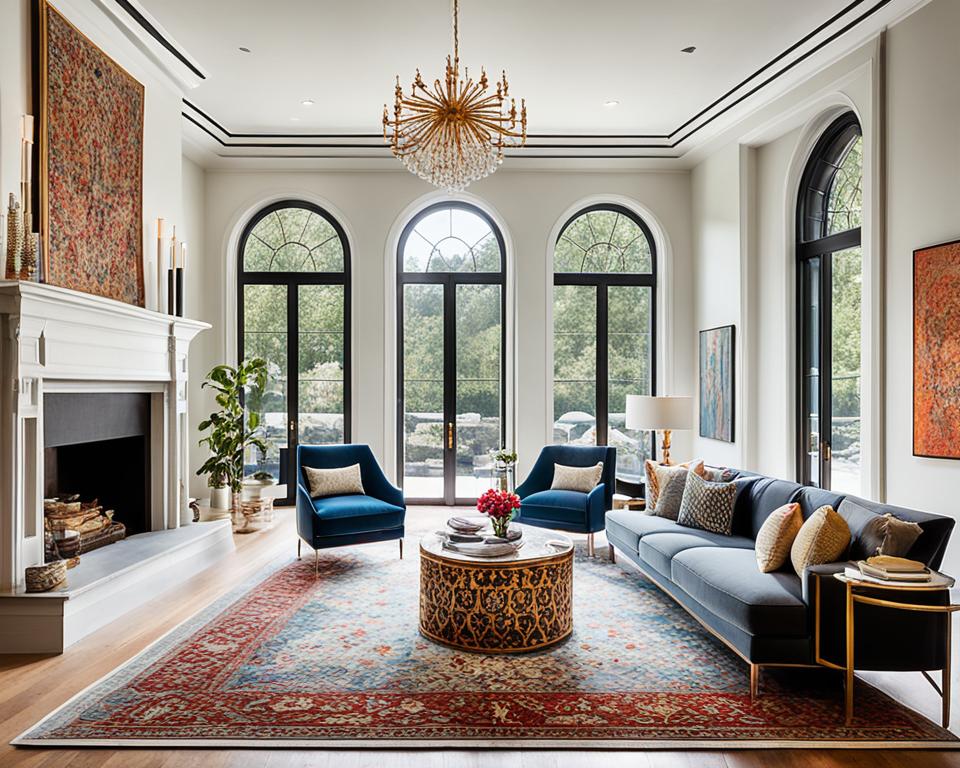
When considering the addition of an Oriental rug to your home, self-reflection on your living situation is paramount. If your household includes playful pets, energetic children, or is subject to frequent visitors, you might ponder how such a rug would fit into your daily life. Given their susceptibility to damage from stains and wear, these exquisite rugs thrive in environments where they can be showcased safely and with respect to their artisanal value.
Selecting the spot where the rug will be placed is also an essential aspect of the Oriental rug journey. Spaces such as formal living rooms, libraries, or personal offices make for an appropriate setting, ensuring that your rug’s vibrance and detail remain intact. Here’s a guide to help determine where an Oriental rug can be best incorporated into your home:
| Room | Suitability | Care Considerations |
|---|---|---|
| Living Room | Suitable for low-traffic areas | Avoid direct sunlight and high-wear zones |
| Dining Room | Chosen with caution | Consider ease of cleaning for potential spills |
| Bedroom | Highly suitable | Maintain humidity control and regular dusting |
| Entrance Hall | Not recommended | Risk of soil and direct wear from outside elements |
Embarking on the path of Oriental rug ownership is a rewarding journey for those ready to invest in more than just a floor covering. With proper care and a suitable setting, an Oriental rug can transcend mere utility, becoming an integral part of your home’s narrative. Informed by this guide, you are now better equipped to decide whether an Oriental rug is a fitting addition to your interior sanctuary.
Real vs. Counterfeit: Spotting Genuine Oriental Rugs
As you explore the diverse market of Oriental rugs, it’s essential to distinguish between real vs. counterfeit rugs. Identifying a genuine piece is crucial, not only for its value but also for its craftsmanship. Here we will unveil the hallmarks of authenticity as well as the warning signs that suggest a rug may not be the real deal. Armed with this knowledge, you’ll be able to invest in a piece that stands as a testament to traditional rug-making excellence.
Common Traits of Authentic Rugs
Truly authentic Oriental rugs, especially top oriental rugs 2021, showcase a heritage of artisanal skill. The unmistakable sign of a real Oriental rug lies in its hand-knotting, an age-old technique that creates intricate patterns and durable structures. Quality materials, such as high-grade wool and silk, are also indicative of a genuine rug. When assessing a rug, examine its knot density or KPSI (knots per square inch), as a higher count generally signals superior craftsmanship. The dyes used in authentic rugs are usually of natural origin, derived from plants and minerals, and offer a unique vibrancy that synthetic dyes can’t replicate.
- Hand-knotted construction
- Premium materials like wool and silk
- High knot density (KPSI)
- Natural dyes with rich color depth
Red Flags in Counterfeit Rugs
Conversely, the market is also rife with counterfeit rugs masquerading as genuine pieces. These fakes often surface at discount sales or furniture stores, where they’re presented with aggressive sales tactics to unsuspecting consumers. Be wary of rugs that boast unrealistically low prices, as this is a telling sign of compromised quality. One of the biggest giveaways of a counterfeit is the rug’s backing, which may cover the wefts and warps to hide poor craftsmanship or machine stitching. A low knot count and jarring imperfections in design continuity are also red flags that you are not looking at a genuine Oriental rug.
- Unusually low prices suggesting inferior quality
- Backings that conceal knots
- Machine-made uniformity
- Sales at unconventional venues like discount outlets
With the resurgence of Oriental rug popularity, including top oriental rugs 2021, staying vigilant against counterfeits is more important than ever. When you’re ready to add one of these beautiful pieces to your home, remember to look for the common traits of authentic rugs and steer clear of the red flags. In doing so, you’ll ensure that your investment enriches your living space with a piece of genuine artistry and tradition.
Workshop vs. Village: Styles of Oriental Rug Craftsmanship
When you’re in the market for an Oriental rug, knowing the difference between workshop and village rugs is essential in selecting a piece that meets your expectations for quality and artistry. Best oriental rug brands often emerge from dedicated workshops, where the process is overseen by a master weaver. These premium oriental carpets stand out for their precision and uniformity, accentuating the elegance of any room they grace.
Workshop rugs typically feature higher knot counts, which is directly correlated with detail and durability. When you come across a rug crafted in a professional workshop, you’re looking at a product of laborious effort and consistency, designed and executed to meet a set standard of excellence. Each thread is a testament to the legacy of the brand and the skill of its artisans.
However, village-made Oriental rugs offer their own unique charm. These pieces often reflect the individual artistry and traditions of the local community, giving each rug its distinct character. They represent a more free-form approach to rug making, where creative expression reigns above strict adherence to design specifications. While they may not always match the meticulous quality control of workshop rugs, they shine in their authenticity and personal touch.
| Feature | Workshop Rugs | Village Rugs |
|---|---|---|
| Knot Count | Higher, more intricate designs | Varies, often lower than workshop |
| Materials | Finer materials for premium quality | Locally sourced materials |
| Designs | Predetermined and uniform | Sporadic and unique to each weaver |
| Quality Control | Strict and consistent | Dependent on individual weaver’s skill |
| Cultural Significance | Crafted for wider appeal | Reflects local heritage and tradition |
If your preference tilts towards consistency, precision, and refinement in a luxury item, a workshop Oriental rug will probably be best suited to your needs. The promise of quality and a reliable brand name comes from these controlled environments. On the other hand, if your heart is set on an authentic piece with a story, a village-made rug might call to you, celebrating the spontaneous spirit of its origins.
In your quest for the perfect Oriental carpet, take into consideration both types of craftsmanship. The best oriental rug brands recognize the beauty in each approach, offering an array of choices for discerning buyers like you seeking premium oriental carpets.
Essential Tips for Verifying an Oriental Rug’s Authenticity
As you navigate through the exquisite world of Oriental rugs, it’s crucial to ensure the authenticity of your potential heirloom. With this oriental rug buying guide, you’ll be equipped with the essential tips for determining authenticity, empowering you to make an informed investment in these handcrafted treasures.
Key Quality Indicators
High Knot Density: Authentic Oriental rugs are celebrated for their intricate hand-knotted designs. A high knot count, often exceeding 200 knots per square inch, signifies a densely woven rug synonymous with quality and durability.
Familiar Design Patterns: Genuine Oriental rugs may include specific motifs and patterns that have been traditionally associated with their heritage. Recognizable designs can serve as a guidepost for authenticity.
Real Silk Fringe: True Oriental silk rugs should have fringes that are an extension of the rug’s foundation, not sewn on after the fact. This is a subtle yet telltale sign of an artisanal, authentically made rug.
Visual Inspection Tips
Begin with a visual inspection to discern the telltale hallmarks of an Oriental rug’s genuine quality:
- Turn the rug over to inspect the reverse side. Authentic rugs display the same vibrant patterns on the back, indicating the high caliber of hand-knotting.
- Examine the fringe; real hand-knotted rugs have fringes as a natural extension of the weave, not added as an afterthought.
- Look for slight irregularities in the weave, which suggest the human touch of the weaver as opposed to the machine-made regularity.
When you seek to include an oriental masterpiece in your collection, remember the importance of purchasing from reputable dealers who provide reliable information about the rug’s origins. A well-versed seller will be eager to share the rug’s storied past, the artisan’s craft, and the region from which it hails.
Guided by these tips for determining authenticity, you’re well on your way to selecting an Oriental rug that is not just a decorative element but a piece of history to cherish for years to come. Embrace the journey of discovery and allow your senses coupled with informed knowledge to lead you to the rug that truly speaks to your space and spirit.
The Oriental Rug Buying Guide: Making an Informed Purchase
Embarking on the quest for the perfect Oriental rug requires patience and a touch of detective work. Whether you’re drawn to the intricate designs of the top oriental rugs 2021 or timeless pieces with historical significance, an informed purchase rests on a foundation of thorough research. Your oriental rug buying guide is here to arm you with the knowledge necessary to select a rug that’s not just a showpiece, but a story woven in fabric and tradition.
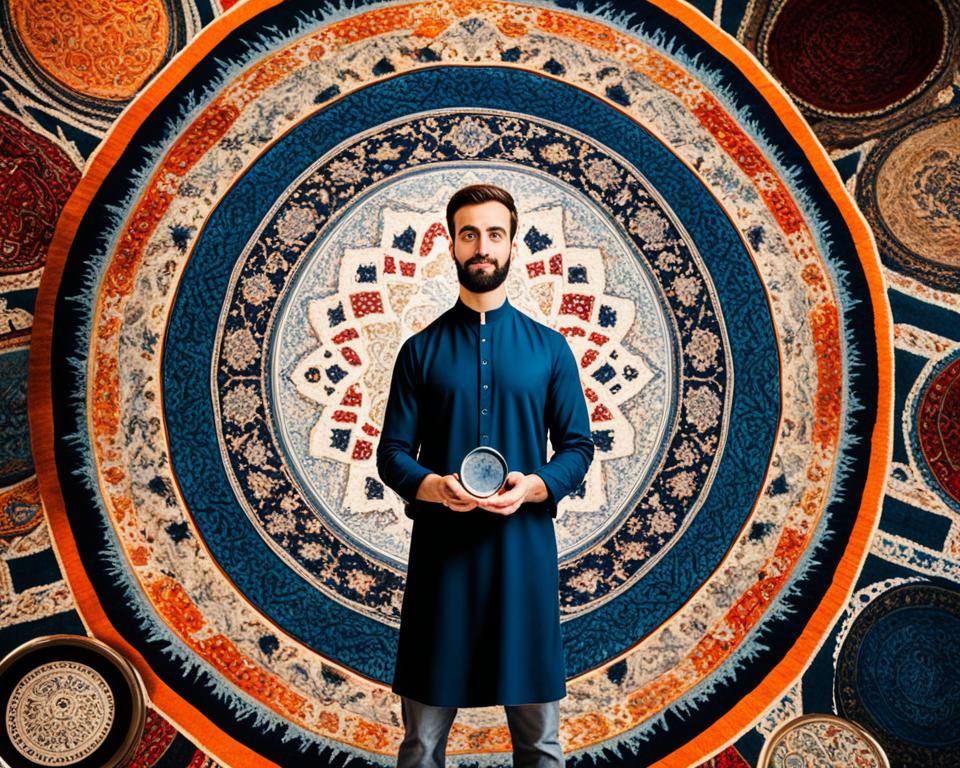
First, delve deep into the rug’s past. The history of an Oriental rug often holds the keys to its character, influencing not only its aesthetic but also its value. Inquire earnestly about the craftsmanship, from the knot density to the techniques used by the weaver. Confirm whether the dyes are natural, deriving from the earth and botanicals, or synthetic, offering vibrancy and consistency.
The adage “beauty is in the details” rings especially true in the world of luxury textiles. Each knot, dye, and fiber tells a story of cultural heritage and meticulous labor. Knowing these details not only assures you of quality but also imbues a deeper connection to your chosen rug, as if it were specially crafted for you and your space.
| Aspect | What to Look For | Why it Matters |
|---|---|---|
| History & Provenance | Origin, age, and prior ownership | Authenticates the rug and potentially increases value |
| Craftsmanship | Hand-knotted construction, fiber quality | Indicates durability and artisanship |
| Dyes | Natural vs. synthetic dyes used | Affects color longevity and rug care |
| Budget | Price relative to size, material, and uniqueness | Helps in making a financially responsible choice |
Crafting a budget is the next crucial step in your Oriental rug journey. Articulate your financial constraints while weighing the rug’s dimensions, materials, and singularity. A silk rug’s delicate sheen or the resilient warmth of high-grade wool may command a premium, influencing your budget. However, this is not an expense but rather an investment in a masterpiece that can grace your floors for generations to come.
Armed with this knowledge and guided by your innate tastes, you now stand at the threshold of making an informed and discerning purchase. Let your oriental rug buying guide lead you to a piece that’s not just an addition to your home but a fragment of history, as enduring and singular as your own story.
Care and Maintenance: Ensuring the Longevity of Your Oriental Rug
Protecting the intricate beauty and handcrafted elegance of your Oriental rug is not just a duty; it’s a commitment to preserving a piece of art. The proper care and maintenance of Oriental rugs is essential to ensure they endure as cherished heirlooms, maintaining their luxurious appeal for years to come. Understanding the basic steps of regular cleaning and the importance of damage prevention can add decades to the life of your rug.
Regular Cleaning and Care
Your thoughtful approach to cleaning goes a long way in safeguarding the delicate fibers and rich colors of your Oriental rug. Gentle vacuuming without a beater bar prevents the fibers from being pulled out and ensures dust and dirt accumulation doesn’t compromise the rug’s integrity. Equally important is rotating your rug periodically. This aids in preventing uneven wear, especially in areas of direct traffic or sunlight exposure. In essence, regular cleaning and attentive rotation are the hallmarks of diligent Oriental rug stewardship.
Damage Prevention and Professional Services
Being mindful of your rug’s placement can significantly mitigate potential damage. Avoid placing your treasured rug in high-traffic areas where the risk of spills or soil is greatest. Direct sunlight, too, can be a foe to the vibrant dyes, causing them to fade prematurely. When incidents occur, as they invariably do, seeking professional cleaning and repair services promptly can revitalize your rug, addressing issues before they become irreparable. These experts specialize in the care and maintenance of Oriental rugs, ensuring that each unique piece receives the custom care it deserves.
By embracing these essential care guidelines, you’re not just maintaining a rug; you’re preserving an art form. So treat your Oriental rug with the reverence it deserves, and it will continue to be a source of beauty and pride for generations to enjoy.
Materials Mastery: Wool and Silk Oriental Rugs
Embarking on the quest for a luxurious enhancement to your space leads many to the undeniable charm of premium oriental carpets. Central to their allure is the mastery of materials — wool and silk — both of which are pivotal in creating authentic handmade rugs. As you edge closer to owning one of these artistic masterpieces, understanding the fabric of their creation is as essential as the craftsmanship itself.
In your pursuit of the perfect rug, you’ll find that wool is the bastion of durability among the materials commonly used. Woolen Oriental rugs offer a resilience that accommodates the high-traffic areas of your home, making them a versatile addition. While not as opulent as their silk counterparts, wool rugs present an exceptional balance between cost and lifespan.
Silk, on the other hand, is the epitome of finery in the world of authentic handmade rugs. Lustrous and delicate, these rugs command attention with their intricate details and vivid colors. However, such beauty comes with a need for meticulous care, positioning silk rugs in spaces of tranquility and minimal wear.
It is between these threads that the story of each rug is woven — a narrative of not just provenance, but the essence of quality that defines premium oriental carpets. Each material contributes to the rug’s overall narrative, whether it’s the enduring robustness of wool or the exquisite finesse of silk.
| Material | Characteristics | Suggested Placement | Care Level |
|---|---|---|---|
| Wool | Durable, resilient, cozy | Living areas, hallways | Moderate |
| Silk | Delicate, lustrous, intricate | Formal spaces, low-traffic zones | High |
As you contemplate the ambiance of your abode, consider how the splendor of silk or the warmth of wool can complement your living environment. The interplay between material and setting is a harmonious dance; one destined to enhance the narrative of your home. With careful thought to their placement and maintenance, you will ensure that the premium oriental carpets you select will endure as an enduring manifestation of refinement and taste.
Field Testing for Authenticity: Practical Insights
Acquiring an authentic Oriental rug is not just a matter of aesthetics—it’s an investment in craftsmanship and history. While an in-depth oriental rug review can provide a wealth of information, nothing compares to hands-on testing for verifying the authenticity of these treasured textiles. Below, discover pragmatic approaches to assess the genuineness of Oriental rugs, taking caution to preserve their integrity during examination.
Hands-On Rug Testing
An astute collector knows that the true essence of an Oriental rug lies in its intricate hand-woven character. When a comprehensive oriental rug buying guide and visual inspections aren’t enough, tactile and closer examinations come into play. One practical insight involves flipping the rug to observe its underside. Authentic hand-knotted rugs will often reveal the pattern in reverse, with visible knots and a continuation of the design, speaking to the artisan’s skillful craftsmanship.
Inspecting the base of the pile for knots or discerning pattern markings can provide a window into the rug’s origins—affirming the hand-knotted techniques passed down through generations.
Another assessment is to gently tug at the fringe. If the fringe seems to be an extension of the rug rather than an added embellishment, you could be holding a genuine Oriental rug. Even the feel of the rug under your fingertips can be telling—authentic Oriental rugs are dense with a smooth pile, a testament to the quality of materials used.
Seeking Professional Authentication
Despite the effectiveness of personal assessment techniques, seeking professional authentication remains the gold standard for confirming the authenticity of an Oriental rug. Rug experts and certified appraisers bring a depth of knowledge, often capable of identifying the rug’s origins, materials, dye quality, and approximate age. Their validation carries weight, especially when considering high-value purchases or ensuring the addition of a legitimate collectible to your decor.
To solidify your investment with confidence, it’s advisable to pursue validation from recognized professionals. They offer not just peace of mind but also valuable documentation that can elevate the provenance and value of your Oriental rug.
Embark on your Oriental rug journey with these insights and trust in qualified authorities for final authentication. The blend of personal hands-on testing and expert evaluation will ensure that your chosen Oriental rug is not only beautiful but brimming with authentic allure and lasting heritage.
Oriental Rug Review: Evaluating Quality and Craftsmanship
Embarking on an oriental rug review involves more than admiring the pattern and color; it is an exploration into the realm of quality and craftsmanship. Discernment in selecting an Oriental rug is paramount, therefore understanding how to evaluate its intrinsic worth is essential. Here are key considerations to guide you through an informed oriental rug review.
Initial attention should be centered on the **knot count**. Renowned for their density and intricacy, Oriental rugs with a higher knot count typically exhibit remarkable detail and durability. This count, also known as knots per square inch (KPSI), can offer you a quantifiable measure of workmanship.
The material used in the rug’s construction is a telling indicator of its quality. Wool and silk are commonly sought-after materials due to their resilience and luxurious feel, respectively. Well-crafted rugs boast materials that are not only visually pleasing but also enduring.
An even and precise weave speaks volumes about the rug’s craftsmanship. During your oriental rug review, an evenly woven rug should feel balanced and uniform, contributing to both its aesthetic appeal and structural integrity.
The **precision of the rug’s design** is another critical aspect to consider. Whether it features traditional motifs or more contemporary patterns, a well-executed design should be symmetrical and clear, showcasing the skilled hand of the weaver.
Finally, the **fringe** of an Oriental rug can provide insight into its authenticity. Authentic rugs typically have fringes that are an extension of the rug’s structure, whereas counterfeit versions might have glued or sewn-on fringes.
Reflecting on these aspects provides a holistic approach to an oriental rug review, ensuring that the piece you select is of high-caliber craftsmanship. **Expert oriental rug reviews** often emphasize these elements to help you discern the truly luxurious rugs from the lesser counterparts. Now, let’s take a closer look at each attribute that signifies excellence in Oriental rugs.
| Review Element | Details | Significance |
|---|---|---|
| Knot Count (KPSI) | High number of knots per square inch | Indicates detailed patterns and lasting durability |
| Material | Wool, silk, or a combination thereof | Affects the rug’s texture, sheen, and longevity |
| Weave Uniformity | Even distribution and tightness of weave | Ensures a smooth surface and structural stability |
| Design Execution | Symmetrical and consistent patterns | Reflects the weaver’s skill and design fidelity |
| Fringe Authenticity | Direct extension of the rug’s weave | Sign of a rug’s authenticity and integral design |
Whether you’re a seasoned collector or a first-time buyer, embracing these elements will elevate your ability to conduct a thorough oriental rug review. Consider not only the immediate visual appeal but also the more profound indicators of craftsmanship that signify a truly exceptional piece.
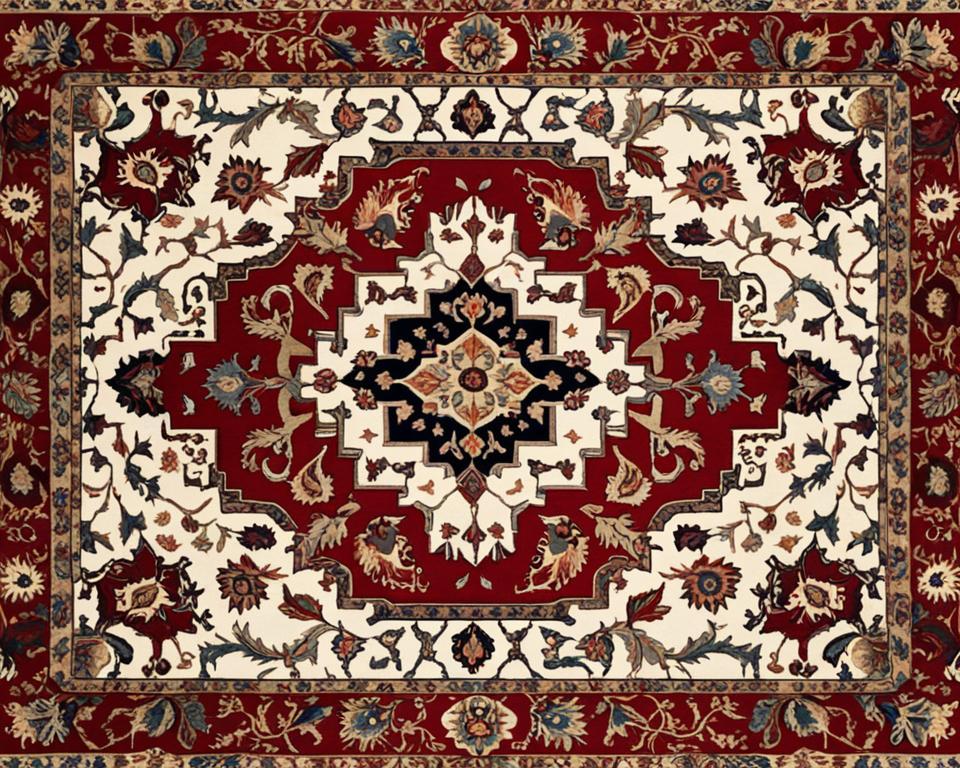
Remember, when enlisting expert oriental rug reviews, these professionals scrutinize the minute details that often go unnoticed. They assess every thread, knot, and color to ensure the rug not only meets aesthetic standards but also embodies the storied history and skilled workmanship inherent to genuine Oriental rugs.
Rely on these insights during your quest for the perfect rug, and trust that your careful consideration will lead you to a piece that will resonate with beauty and tradition in your home for years to come.
Best Oriental Rug Brands: A Curated Selection
When you’re in search of luxury rug recommendations, identifying the best oriental rug brands becomes a pursuit of both beauty and quality. The craftsmanship of premium carpet manufacturers is evident in the weave of every rug they produce, making them standouts in a rich tapestry of history and design. Our curated guide aims to highlight the crème de la crème of oriental rug makers, whose exemplary works are celebrated across the globe.
Uncovering Premium Carpet Manufacturers
The distinction of the finest Oriental rugs often lies in the detail and material quality of premium carpet manufacturers. Renowned for their expert weaving techniques and luxury materials, these brands epitomize the pinnacle of rug craftsmanship. Each piece is a testament to their dedication to artistry and the cultural legacy embodied in each pattern.
Connoisseurs of decor understand that a brand’s reputation and history in rug-making are as important as the rug’s aesthetic appeal. The best oriental rug brands inspire confidence through generations of crafting exceptional rugs that go beyond mere floor coverings – they conjure an aura of elegance that only true mastery can achieve.
Luxury Rug Recommendations and Reviews
Expert reviews and personal recommendations become invaluable when choosing a luxury oriental rug for your space. These resources provide an honest assessment of a brand’s latest offerings and classic designs, steering you towards high-quality options that align with both contemporary and traditional interiors.
Armed with insights from seasoned interior designers and rug aficionados, you can navigate the diverse market with a sharpened eye for luxury. Their endorsements are often based on years of experience and a deep understanding of what constitutes a superior Oriental rug – considering factors such as knot density, dye quality, and artistic expression.
Below, find a table summarizing key considerations praised by experts when recommending the best oriental rug brands.
| Brand Attribute | Significance for Luxury Rugs |
|---|---|
| Material Quality | Indicates durability and plushness of the rug. |
| Artistic Design | Reflects cultural authenticity and aesthetic appeal. |
| Weaving Technique | Signifies craftsmanship and attention to detail. |
| Brand Heritage | Assures a legacy of quality and trustworthiness. |
| Review Ratings | Provides consumer consensus on overall satisfaction. |
In your quest for the ideal Oriental rug, consider these luxury rug recommendations and the legacy of the brands they endorse. Allow the fusion of art and craftsmanship from esteemed manufacturers to elevate your home decor to new heights of sophistication.
Timelessness vs. Trendiness: The Sustained Popularity of Oriental Rugs
In the dynamic landscape of home decor, where trends emerge and fade with the changing seasons, the allure of Oriental rugs endures. An oriental rug review is not just a testament to a rug’s present-day appeal but a chronicle of its ceaseless charm that captivates the hearts of homeowners decade after decade. It is this timeless beauty and cultural richness that have cemented Oriental rugs as a mainstay in both traditional and contemporary homes.
One might wonder how these elegant floor coverings have stood the test of time, even as the currents of interior design trends continue to shift. The answer lies in the rugs’ intricate designs and supreme craftsmanship—a union that appeals to a wide spectrum of aesthetics and preferences. They represent a confluence of art, history, and utility that transcends the superficialities of trendiness.
Take, for instance, the top oriental rugs 2021—each one tells a story not just through its patterns but through the very fibers that interlace to form its structure. Picture the awe-inspiring artistry that breathes life into each rug; it is this meticulous attention to detail that captures the admiration of discerning collectors and casual decorators alike.
There is an oriental rug for every season and reason, and its versatility ensures it never falls out of favor.
What truly sets these pieces apart is their innate ability to adapt. Whether they lay on the floor of a sleek, modern loft, accentuating clean lines and minimalist design, or anchor the furniture in a warm and inviting rustic country home, they invariably find their place. They can be the centerpiece that draws the eye or the subtle backdrop that completes a room’s ensemble.
Beyond their aesthetic adaptability, Oriental rugs are celebrated for their robust construction, often surviving generations of use with minimal signs of wear. It’s this resilience and enduring nature that contribute to their sustained popularity. Here’s a glance at the factors that keep Oriental rugs evergreen:
| Quality Factor | Contribution to Rug’s Timelessness |
|---|---|
| Artisanal Craftsmanship | Celebrates hand-weaving techniques passed down for centuries |
| Cultural Heritage | Encapsulates designs and motifs rich in history |
| Durability | Built to withstand the test of time and trends |
| Timeless Aesthetic | Designs that harmonize with multiple decor periods and styles |
As you contemplate incorporating one of these venerated textiles into your home, understand that you are choosing more than just a rug—you are electing for a legacy of artistry and endurance. The oriental rug review process will lead you to a discovery of diversity, with choices spanning various regions, styles, and eras.
From the vibrant markets of Tehran to the ancient weaving looms of Anatolia, each rug carries within its knots and fibers the essence of its origins. This essence, timelessly interwoven into each piece, ensures that Oriental rugs remain cherished elements of home decor. Whether swayed by fashion or functionality, one thing remains clear: the Oriental rug’s ability to outlast trends renders it a choice that is both sensible and stylized.
The Aesthetic Appeal and Cultural Value of Oriental Rugs
The enchantment of Oriental rugs goes far beyond their surface beauty. These exquisite pieces are not simply accessories; they are a symphony of history, art, and storytelling interwoven into each thread. Rich in cultural significance, Oriental rugs capture the essence of persian designs and symbolic narrative, turning every rug into a canvas of cultural stories. Discerning enthusiasts of vintage rug reviews understand that embedded within the patterns are tales from centuries past, making these rugs invaluable treasures in the world of interior décor.
Persian Designs and Their Symbolism
Delve into the world of Persian rug designs, and you’ll find a complex language of symbolism. Every curve and weft speaks volumes about traditions, beliefs, and even the aspirations of the societies from which they originate. Take the classic ‘boteh’ pattern, for instance, often interpreted as a representation of life and eternity. It’s no coincidence that such motifs have lent Persian rugs an almost mystical allure that continues to capture imaginations today.
Immerse yourself in the storytelling woven into the very fabric of Persian rugs and you’ll come to understand their enduring appeal.
Cultural Stories Woven into Patterns
Each Oriental rug narrates a time-honored tale, with cultural stories woven into patterns, revealed to those who appreciate the depths of their artistry. These stories range from depictions of battles and legends to portrayals of seasonal change and natural elements, each selected thread contributing to the overarching narrative. As a focal point of any room, an Oriental rug not only enhances the space visually but also enriches it with a palpable sense of history and culture.
In today’s market, vintage rug reviews often highlight rugs renowned for their embodiment of such ancestral tales, affirming both their aesthetic appeal and their cultural value. When you choose an Oriental rug, you’re not just selecting a home accessory; you’re bringing a piece of history into your living space that resonates with tales of yore.
| Design Element | Symbolic Meaning |
|---|---|
| Boteh | Eternity and life |
| Floral Motifs | Nature and springtime rebirth |
| Geometric Borders | Protection and structure |
| Central Medallion | Central focus, mirroring the mosque’s dome |
| Repeating Patterns | Infinite nature of existence |
Whether you are an experienced collector or seeking your first piece, let the enduring beauty and intricate storytelling of Oriental rugs captivate and inspire you. With each glance and every step, enjoy the majestic beauty and profound stories laid out at your feet.
Conclusion
As we draw this oriental rug review to a close, we recognize that these authentic handmade rugs are much more than mere decorations; they are timeless narratives of extraordinary craftsmanship and cultural legacy. For you, the discerning consumer, luxury rug recommendations serve as a beacon towards obtaining a piece that not only complements your decor but also resonates with a deep historical significance. Guided by expert insights and comprehensive guides, you have the tools to discern the quality and authenticity needed to enhance your living experience with a rug that truly embodies luxury.
Throughout this exploration, you’ve equipped yourself with the knowledge to navigate the intricate world of Oriental rugs. From understanding the diversity between Persian and Oriental rugs to identifying the traits of a true artisanal weave, you stand prepared to make an informed selection. Whether seeking to grace your floors with vibrant silk threads or the warm embrace of premium wool, it’s clear that the value of an Oriental rug transcends its immediate aesthetic appeal, fostering an investment in beauty that lasts.
Your journey into the enchanting domain of oriental rugs concludes with the assurance that your discernment, aided by authentic sources, has prepared you to select a rug that speaks uniquely to your space. Embrace the luxury rug recommendations and revel in the splendor of selecting an authentic handmade rug, a treasure that will endure and tell its story in the tapestry of your life’s setting.
FAQ
What defines an authentic Oriental rug?
Authentic Oriental rugs are hand-knotted with natural fibers such as wool or silk and feature traditional designs from regions including Iran, India, Turkey, and Afghanistan. They also boast a high knot density and natural dye use.
How can I tell if an Oriental rug is handmade?
Look for signs such as irregularities in design and knotting, a hand-knotted fringe originating from the rug’s ends, and the overall craftsmanship. Authentic handmade rugs will have a soft backing where you can see the individual knots.
Are all Persian rugs considered Oriental rugs?
Yes, all Persian rugs are Oriental rugs, but not all Oriental rugs are Persian. Persian rugs originate from Iran, while Oriental rugs can come from a variety of countries within the broader “Oriental” region.
What should I consider before buying an Oriental rug?
Consider the rug’s origin, material, craftsmanship, knot count, and design. Establish a budget and determine the appropriate size and style for your space. It’s also important to buy from a reputable dealer and ask for the rug’s history.
What maintenance is required for Oriental rugs?
Regular vacuuming, avoiding direct sunlight, and rotating the rug to even out wear are important. Address spills immediately, and for deep cleaning or repairs, consult a professional who specializes in Oriental rugs.
How can the authenticity of an Oriental rug be verified?
Look for key quality indicators like high knot density, natural dyes, and traditional design patterns. Purchasing from a reputable dealer and obtaining a certificate of authenticity can also help verify an Oriental rug’s authenticity.
What are common traits of counterfeit Oriental rugs?
Counterfeit rugs often have machine-made knots, synthetic fibers, glued-on fringes, and lack the fine craftsmanship of authentic rugs. They may also be sold through misleading marketing, like ‘going out of business’ sales.
What is the difference between workshop and village Oriental rugs?
Workshop rugs usually have a higher knot count and are created under the supervision of a master weaver with set designs. Village rugs can be more creative in design but might not have the same quality control as workshop rugs.
Why are Oriental rugs considered valuable?
Oriental rugs are valued for their artistry, craftsmanship, durability, and the cultural history they carry. High-quality materials, the labor-intensive process, and the longevity of these rugs contribute to their value and appeal.
Can Oriental rugs be integrated into modern decor?
Absolutely! Despite their traditional origins, Oriental rugs can enhance modern interiors by adding warmth, history, and a sense of craftsmanship. Their rich colors and patterns can serve as a focal point or complement a contemporary aesthetic.
What role does symbolism play in Persian and Oriental rug designs?
Persian and Oriental rug designs are replete with symbolism, often representing historical, spiritual, and natural themes. Each pattern, motif, and color can have a specific meaning, telling a story or conveying a message from the weaver.
How does one choose the best Oriental rug brand?
Look for brands with a reputation for quality craftsmanship, use of premium materials, and adherence to traditional weaving techniques. Research reviews and seek recommendations from rug experts and trusted sources.
